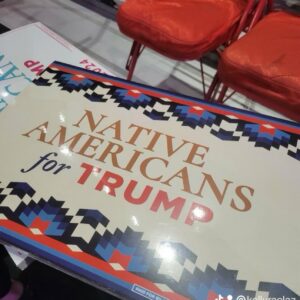Political pundits were stunned by Donald Trump’s strong support among “POC” — people of color — a surge that helped sweep him to both the White House and a popular vote victory. But while the media coverage has focused on Trump’s improvement among Black and Hispanic voters, the group where Trump scored his biggest win?
Native Americans.
Exit polling from NBC News found Trump won 65 percent of the vote from “American Indians” (the term used by the pollsters), compared to 57 percent of votes from White Americans.
In Robeson County, NC, where the Lumbee Tribe, which has been fighting for full recognition from the federal government since the 1880s, has its headquarters, Trump took 63.3 percent of the vote. That’s a four-point increase over his 2020 count.
“Tribal leaders, we’re just trying to take care of our own people,” former Navajo Nation Vice President Myron Lizer told InsideSources. “We’re tired of the same old, and there’s a lot of people in our movement.”
Lizer spoke at the 2020 virtual Republican National Convention and stumped for Trump at a rally in Albuquerque, N.M., in late October. In his view, it’s time for “Indian Country” to make its presence known in American politics.
“We are wards of the federal government,” Lizer said, referring to historical agreements under which the federal government owns tribal lands while recognizing the sovereignty of tribes. “We don’t want to have our hand out to the fed government all the time; that’s a bad posture. We want to send the message that Indian country is open for business. We have the land; we have the resources. We need the jobs.”
Native Americans have reliably voted Democrat. Republicans have spent years chipping away at that advantage. Trump’s late September announcement that he would sign legislation granting the Lumbee Tribe full federal recognition is just one example of GOP outreach to the community.
A national survey from Native News Online released in late October found that Alaska Natives and Native Hawaiians were throwing their support to Trump, although neither he nor Harris topped 50 percent. Trump pulled 44.88 percent in that poll, compared to Harris’ 37.44 percent.
“Similar to polls conducted nationwide among the general population, the Native News Online survey shows that Native voters are concerned about the high prices of everyday goods,” Native News Online reported. “Inflation was the top issue, followed by jobs and the overall economy. The third top issue was Native American issues.”
Political analyst Nate Silver, founder of 538, tweeted a link to reporting from NBC News highlighting Trump’s gains among Native American voters and commented, “10-to-15 point swing toward Trump in Navajo Nation. Guess we didn’t do enough land acknowledgments?”
Additional reporting from Politico found that the four counties in Montana reporting the “sharpest shifts to the right” were predominately Native American. There are similar stories in New Mexico and Minnesota where counties with the largest populations of Native Americans moved sharply to the right.
Rev. Dr. Lauren R. Stanley of the Episcopal Diocese of South Dakota, however, disputed that Native American voters are shifting toward Trump.
“If you actually look at the reservations, they’re blue,” she told InsideSources, arguing that NBC’s exit polling was done in urban areas.
Stanley suggested that NBC would have found a very different result in places such as Rapid City, S.D. However, Pennington County — home of Rapid City — overwhelmingly supported Trump, 62 to 35 percent. Harris won just five of South Dakota’s 66 counties.
Stanley believes disputes between Trump’s desire to “drill, baby, drill” and Native American concerns about tribal sovereignty will collide, and any alliance will be short-lived.
But political pundits say the real issue for Native Americans is, like many of their fellow voters, the economy.
Unemployment on Native American reservations is shockingly high. According to Census data, they’re suffering an average of 10.5 percent unemployment, with some areas seeing an 80 percent unemployment rate. In addition, inflation hits low-income families the hardest, and Native Americans have among the lowest average household incomes of any group in America.
“The American Indian and Alaska Native median household income is $35,310 compared with $51,371 for the United States as a whole,” according to the federal Administration for Native Americans. “The poverty rate for American Indians living on reservations is 29.4 percent compared with the U.S. national average of 15.3 percent.”
“The political system has left the sovereign nation behind because they are not down here, just maybe listening,” Arizona Republican Party Chair Gina Swoboda said during an event at the Navajo Nation Fair. “President Trump tried very hard to do that, listening, to do outreach and to make sure he had representatives here in the nations.”
While Native American voters do have specific concerns about their tribe’s sovereignty and improving life on reservations, Swoboda suggested that Trump’s promises to fix the economy would resonate.
“If you’re living out here, you have to haul water, and you usually have to travel something like 45 miles to get to where to get the water and then back,” she said. “If you’re looking at gas prices that are out of control, it’s going to cripple you.





